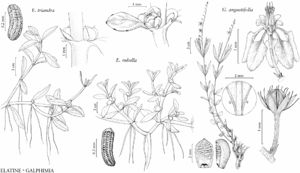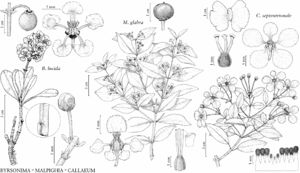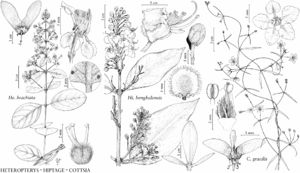FNA>Volume Importer |
(change the copyright on illustrations to University of Michigan Herbarium) |
||
| (2 intermediate revisions by one other user not shown) | |||
| Line 187: | Line 187: | ||
|family=Malpighiaceae | |family=Malpighiaceae | ||
|illustrator=Karin Douthit | |illustrator=Karin Douthit | ||
| − | |illustration copyright=University of Michigan | + | |illustration copyright=University of Michigan Herbarium |
|distribution=Nearly worldwide;tropics and subtropics. | |distribution=Nearly worldwide;tropics and subtropics. | ||
|reference=anderson2004a;anderson2013a;davis2010a;niedenzu1928a | |reference=anderson2004a;anderson2013a;davis2010a;niedenzu1928a | ||
| Line 193: | Line 193: | ||
|publication year= | |publication year= | ||
|special status= | |special status= | ||
| − | |source xml=https:// | + | |source xml=https://bitbucket.org/aafc-mbb/fna-data-curation/src/2e0870ddd59836b60bcf96646a41e87ea5a5943a/coarse_grained_fna_xml/V12/V12_812.xml |
}}<!-- | }}<!-- | ||
-->[[Category:Treatment]] | -->[[Category:Treatment]] | ||
Latest revision as of 18:52, 26 April 2021
Herbs, subshrubs, shrubs, vines (twining, woody to herbaceous), or trees, perennial, evergreen or deciduous, synoecious [dioecious or functionally dioecious]; hairs unicellular, usually 2-armed and medifixed or submedifixed [basifixed or stellate]. Leaves opposite [whorled, subopposite, or alternate], simple; stipules present [absent]; petiole present [absent]; blade margins usually entire [lobed], sometimes pseudodentate [ciliate at location of marginal glands or with stout bristlelike hairs], often bearing multicellular glands on margin or abaxial [adaxial] surface; venation pinnate. Inflorescences terminal or axillary, racemes, panicles, umbels, corymbs, or thyrses, or flowers solitary. Flowers bisexual [rarely unisexual], radially or bilaterally symmetric, mostly all chasmogamous, sometimes both chasmogamous and cleistogamous; perianth and androecium hypogynous [perigynous]; hypanthium absent [present]; sepals 5, distinct or connate basally, usually glandular, sometimes eglandular; petals (in chasmogamous flowers) 5, posterior (flag) petal often different from lateral 4, distinct, mostly clawed; nectary absent; stamens (in chasmogamous flowers) (2–5)[6–]10[–20], distinct or connate proximally, free; anthers dehiscing by longitudinal slits [apical or subapical pores or very short slits]; pistil 1, (2–)3-carpellate, carpels nearly distinct to completely connate in ovary [connate throughout], ovary superior, (2–)3-locular, placentation apical; ovule 1 per locule, anatropous; styles (in chasmogamous flowers) (1–)3 (usually as many as carpels but sometimes fewer by reduction [or connation]), distinct [partially to completely connate]; stigmas 1–3 (1 per style). Fruits drupes or schizocarps splitting into mericarps, mericarps nutlets, thin-walled cocci, or bearing wings [or vascularized setae] [berries or dry and indehiscent]. Seeds 1 per locule or mericarp.
Distribution
Nearly worldwide, tropics and subtropics.
Discussion
Genera ca. 75, species ca. 1300 (8 genera, 9 species in the flora).
Malpighiaceae are far more numerous and diverse in the New World than in the Old World. Many are grown as ornamentals in warm areas of the world; they are intolerant of cold. Malpighia emarginata de Candolle produces a fruit that is rich in vitamin C, which has been exploited commercially as acerola. One of the most famous hallucinogens in the world, ayahuasca or caapi, is extracted from Banisteriopsis caapi (Grisebach) C. V. Morton, a vine native to South America but cultivated widely.
In Malpighiaceae, the ancestral inflorescence appears to be a raceme of cincinni, but in most genera the cincinni have been reduced to 1-flowered units. The pedicel is usually borne on a peduncle, the juncture marked by two bracteoles (W. R. Anderson 1981). This morphology technically makes many inflorescences in the family cymose (cymes, dichasia, or thyrses). For simplicity, however, inflorescence types are described here based on their gross morphological appearance, treating reduced cincinni as if they were single flowers.
Most New World taxa bear two (sometimes one) large multicellular glands abaxially on all five sepals or on three or four lateral sepals. Many Old World taxa and some New World taxa (including one in the flora) have the calyx glands much reduced in number and size or absent. Calyx glands always are absent from cleistogamous flowers.
Selected References
Illustrations
Key
| null | . | > 1 |
| 1 | Flowers cleistogamous, to 1.5 mm diam., without visible petals, stamens, or styles. | Aspicarpa |
| 1 | Flowers chasmogamous, 6+ mm diam., showy with visible petals, stamens, and styles. | > 2 |
| 2 | Styles 1(–2) per flower. | > 3 |
| 3 | Petals densely sericeous abaxially, glabrous adaxially, white or pink, except posterior petal proximally lemon yellow, distally white or pink; stamens 10, all fertile; s Florida. | Hiptage |
| 3 | Petals glabrous, lemon or carrot yellow; stamens 2–5, 2 or 3 fertile, 0–3 staminodial; sw United States. | > 4 |
| 4 | Slender wiry twining vines. | Cottsia |
| 4 | Subshrubs or non-twining perennial herbs. | Aspicarpa |
| 2 | Styles 3 per flower. | > 5 |
| 5 | Petals lemon yellow, sometimes becoming orange or red in age. | > 6 |
| 6 | Petals glabrous; calyx glands 0; styles slender, subulate; stigmas minute, terminal; subshrubs or shrubs. | Galphimia |
| 6 | Petals abaxially white-sericeous or -tomentose; calyx glands 8 (anterior sepal eglandular, 4 lateral 2-glandular); styles stout, cylindric; stigmas large, on internal angle; woody vines or shrubs with scandent or trailing branches. | Callaeum |
| 5 | Petals pink, pink and white, lavender, white, or red. | > 7 |
| 7 | Woody vines; s Florida. | Heteropterys |
| 7 | Shrubs or small trees; s Florida, s Texas. | > 8 |
| 8 | Inflorescences terminal, racemes; pedicels sessile; stipules intrapetiolar; leaves eglandular; styles slender, subulate; stigmas minute; Florida. | Byrsonima |
| 8 | Inflorescences axillary, umbels or corymbs; pedicels raised on peduncles; stipules interpetiolar; leaves bearing (0–)2–4 glands impressed in abaxial surface of blade; styles stout, cylindric; stigmas large; Texas. | Malpighia |
| 8 | Inflorescences axillary, umbels or corymbs; pedicels raised on peduncles; stipules interpetiolar; leaves bearing (0–)2–4 glands impressed in abaxial surface of blade; styles stout, cylindric; stigmas large; Texas. | Malpighia |
| null | . | > 1 |
| 1 | Fruits drupes. | > 2 |
| 2 | Inflorescences terminal, racemes; pedicels sessile; stipules intrapetiolar; leaves eglandular; Florida. | Byrsonima |
| 2 | Inflorescences axillary, umbels or corymbs; pedicels raised on peduncles; stipules interpetiolar; leaves bearing (0–)2–4 glands impressed in abaxial surface of blade; Texas. | Malpighia |
| 1 | Fruits schizocarps, breaking apart into samaras, unwinged nutlets, or cocci. | > 3 |
| 3 | Mericarps cocci or nutlets, unwinged but bearing dorsal keel or crest. | > 4 |
| 4 | Mericarps bearing narrow dorsal keel, walls thin, brittle; calyx glands 0. | Galphimia |
| 4 | Mericarps with dorsal crest, walls thick, tough; calyx glands in chasmogamous flowers 8 or 10 (sepals all 2-glandular or anterior eglandular), in cleistogamous flowers 0. | Aspicarpa |
| 3 | Mericarps samaras. | > 5 |
| 5 | Samaras bearing 1 elongate dorsal wing, short lateral winglets present or absent. | > 6 |
| 6 | Dorsal wing of samara thickened on abaxial edge, veins bending from it toward thinner adaxial edge; woody vines; Florida. | Heteropterys |
| 6 | Dorsal wing of samara thickened on adaxial edge, veins bending toward thinner abaxial edge; slender wiry vines; sw United States. | Cottsia |
| 5 | Samaras bearing 2 or 3 elongate or semicircular lateral wings, dorsal wing much smaller than lateral wings or absent. | > 7 |
| 7 | Lateral wings of samara 2, semicircular; dorsal wing well developed, like lateral wings but much smaller; Texas. | Callaeum |
| 7 | Lateral wings of samara 3, elongate; dorsal wings mostly absent, occasionally present, much smaller than lateral wings; Florida. | Hiptage |


